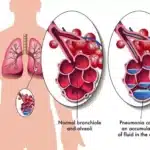What Is Hyponatremia?
Contents
Hyponatremia is a condition where the sodium level in our blood is abnormally low due to excessive water in the body.
Sodium is an electrolyte, which helps to balance the water in our body, and sodium levels should be at 135 to 145 mEq/L.
Whenever the sodium levels are normal, the levels of water retention in the body are also normal.
In some cases, severe hyponatremia is also seen which is a level below 120 mEq/L, so the person needs immediate treatment.
Hyponatremia is a common condition, which affects about 20 to 35% of hospitalized patients.
But this is more common in older patients due to multiple diseases, medicines, and lack of several nutrients (1).
Check Out – Proven Benefits of Coconut Water You Didn’t Know About
Causes of Hyponatremia
Usually, too much water in the body is the main reason for hyponatremia, where excessive water dilutes sodium levels.
Too much water in the body causes our blood to become watery.
However, there are other causes of too low sodium levels in the body which include:
- drinking too much alcohol
- untreated diarrhea
- taking certain medicines that trigger sodium levels like diuretics pills, anti-depressants
- kidney, liver problem
- severe diarrhea or vomitting
- drinking too much water during exercise
- dehydration
- heart issues like heart failure, attack, etc
- Diseases, like Addison’s disease, overactive thyroid, diabetes, and Cushing’s syndrome
- Syndrome of inappropriate antidiuretic hormone (SIADH)
- high blood proteins levels – such as high blood fat level, high blood sugar, and myeloma (2)
- pancreatitis
- 3,4-methylenedioxy-methamphetamine drug intake can result in hyponatremia (3)
In addition, water is necessary during exercise because our body loses a lot of fluid during that time, through sweat.
Lack of water in the body may lead to dehydration causing muscle fatigue, lack of energy, muscle cramp, and difficulty in muscle building.
Signs and Symptoms
Signs and symptoms depend on person to person, patients with mild to moderate hyponatremia have minimal symptoms.
Symptoms’ severity also depends on how fast and how severe the drop in blood sodium level is.
On other hand, patients with severe hyponatremia or a rapid decrease in sodium levels have several symptoms.
Mild signs and symptoms include:
- Headache
- weakness
- fatigue
- nausea
- vomiting
- sweating
- muscle cramps
- sleepiness
- low energy
- irritability
- poor balance in the body (4)
Severe symptoms include:
- Anorexia (an eating disorder to increase low body weight)
- confusion
- memory problems like seizures, coma
- short-term memory loss
- respiratory attack
- excessive fluid in the lungs (5) this is a fatal condition, so immediate treatment is important.
If water enters the brain cells, which causes them to swell, resulting increase pressure in the skull, which causes central nervous system dysfunction.
Hyponatremia may affect bone health, which leads to osteoporosis and increases the risk of bone fracture (6).
In severe cases, death also occurs, if a person doesn’t take immediate treatment or don’t take precaution during treatment (7).
How Are More Risk of Hyponatremia?
Anyone can come under this condition if they drink excessive water in any form like alcohol, but it is more likely to develop in these people including:
- long Hospitalized people
- have issues with kidney, heart, and liver
- who consume excessive alcohol
- older people
- diuretic, and anti-depressant use
- athletes like runners
- eating low sodium diet
- previous had surgery
- living in a warmer climate
How Doctors Diagnose Low sodium Level In the Body?
The doctor will check your sign and symptoms, also a drug, diet history, history of diarrhea, vomiting, and blood test also required.
After asking several questions of patients, doctors come for a physical examination to diagnose hyponatremia exactly (8)
Doctors check sodium levels in the blood and in urine simply called serum sodium level, where sodium level in blood should be 135 to 145 mEq/L.
If the patient’s sodium level is less than 135 mEq/L (Milliequivalents per liter) then it considers hyponatremia.
- The doctor also checks – decreased sodium osmolality (9)
- check urine low and high sodium levels, where 100 mEq/L per 24 hours
- decreases urine specific gravity
- check the patient’s fluid status
If the doctor is still not sure of a diagnosis, then they may perform other tests which include:
- Liver, kidney, and heart function tests
- Imagine test include – an X-ray, of your lungs, and kidneys, a CT scan of your head
Treatment of Hyponatremia
Its Treatment depends on the degree of hyponatremia, acute or chronic, how severe the case is, symptoms, and other statuses.
Treatment also depends on underlying causes, which include:
I/V fluids – if a person has low sodium and fluid, then I/V fluids are considered it depends on how much sodium and fluid is low in the body.
Fluid restriction – if sodium level decrease, due to an overload of fluid, then healthcare uses fluid restriction temporarily.
Steroids – Medications is used to cure underlying condition which causes hyponatremia, or increase low or decreases high sodium levels.
This increase the excretion of water in the kidney without affecting sodium level (10)
Medications also used in people with chronic hyponatremia due to SIADH (is a disorder of impaired water excretion) (11).
NOTE: Before consulting a professional, don’t take any medication by just searching, it may lead to severe cases.
ACE inhibits – Angiotensin-converting enzyme is given, when there is a heart issue like hypertension, where the first heart condition is treated.
If an underlying condition is the main reason, so first treat the disease, which will automatically increase sodium levels.
Chemotherapy – If cancer is the cause of this, then the doctor may give cancer treatments, like radiation therapy.
It is mostly used for cases of breast cancer in stages 2 and 4 (12).
Chemotherapy is a drug treatment that uses powerful chemicals to kill fast-growing cells in your body (13).
Adjusting digirites – like potassium digirites, which remove urine, but as well as decrease sodium concentration.
If a person takes digirites for anemia, hypertension, and other condition, then the doctor consults with the patient to adjust digirites to prevent sodium loss.
In long term, these treatments may be planned to include:
- adjusting or stopping the medication or adding new medicines
- Limited water intake whether it is alcohol
- adding salt to your diet
So How Much Water Should We Drink A Day?
The institute of medicine recommends that women drink no less than 72 ounces (2 liters) of water a day.
As for men, they need more water 104 ounces (3 liters) of water a day.
However, Pregnant women and breastfeeding women require more water about 2.5 to 3L, and children require less water than adults.
But there are also some cases where you need to drink more water than other people:
- You are pregnant or breastfeeding
- if you live in a warm area
- diarrhea, vomiting, and fever patients should increase water intake
- if you are a daily exercise person
Prevention Tips
If you drink a lot of water or alcohol a day, then you should cut the quantity of this, and consult the doctor about water intake.
If you experience any of these symptoms, so immediately talk to your doctor, because it may some other health issues (14)
Here are some ways to prevent hyponatremia which include:
- Keep your water intake and electrolyte level maintain
- do not drink too much water, if you are an athlete, drink the right amount of water
- eat a well-balanced diet
- avoid taking any medication that triggers water or sodium level
When you are enough hydrated, then your urine color will be clear or light yellow, and you won’t feel thirsty.
NOTE – Alkaline Water: Benefits, Negative Effects, And Much
Precautions
There are some precautions that should be taken – Do not raise the serum sodium level expeditiously.
Because raising sodium concentration rapidly may cause osmotic demyelination syndrome (a brain disorder) (15)
And raising rapid correction of sodium levels can lead to CPM (central pontine myelinolysis) (neurological disorder) (16) (17).
Are There Any Complications of Hyponatremia?
If hyponatremia is left untreated, then patients can get complications including mental and physical status include:
- Coma
- osmotic demyelination syndrome
- rhabdomyolysis (a condition, where the breakdown of muscle tissue happens, which causes the release of muscle fiber contents into the blood)
- mental status changes
- seizures
- locked syndrome (where patients are awake but unable to move, and can only communicate with the help of their eyes)
- Even death
Down Line
By drinking more water, your kidney is not able to remove the extra water, which reduces the amount of sodium in the blood and causes hyponatremia.
Water becomes very important during exercise because our body loses a lot of fluid during that time, through sweat.



